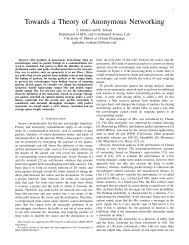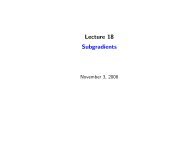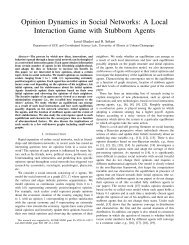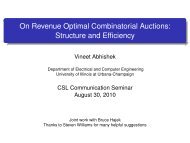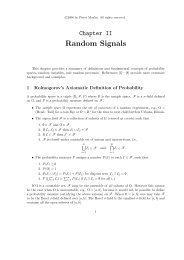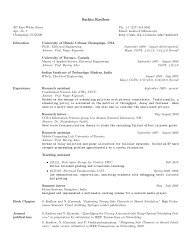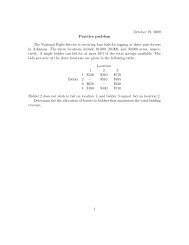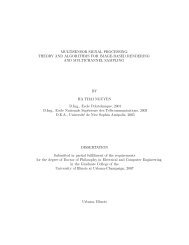neural network-based robust tracking control for magnetic levitation ...
neural network-based robust tracking control for magnetic levitation ...
neural network-based robust tracking control for magnetic levitation ...
Create successful ePaper yourself
Turn your PDF publications into a flip-book with our unique Google optimized e-Paper software.
Generated by Foxit PDF Creator © Foxit Software<br />
http://www.foxitsoftware.com For evaluation only.<br />
NEURAL NETWORK-BASED ROBUST TRACKING CONTROL<br />
FOR MAGNETIC LEVITATION SYSTEM<br />
Thanh Nguyen Duc, Luy Nguyen Tan*, Tan Nguyen Huu,<br />
Division of Automatic Control, HCM University of Technology, Vietnam<br />
*National key lab <strong>for</strong> Digital Control & System Engineering, HCM University of Technology, Vietnam<br />
ABSTRACT<br />
This paper proposes a <strong>robust</strong> <strong>tracking</strong> <strong>control</strong>ler with bound estimation <strong>based</strong> on <strong>neural</strong> <strong>network</strong> <strong>for</strong><br />
the <strong>magnetic</strong> <strong>levitation</strong> system. The <strong>neural</strong> <strong>network</strong> is to approximate an unknown uncertain nonlinear<br />
dynamic function in the model of the <strong>magnetic</strong> <strong>levitation</strong> system. And the <strong>robust</strong> <strong>control</strong> is proposed to<br />
compensate <strong>for</strong> approximation error from the <strong>neural</strong> <strong>network</strong>. The weights of the <strong>neural</strong> <strong>network</strong> are tuned<br />
on-line and the bound of the approximation error is estimated by the adaptive law. The stability of the<br />
proposed <strong>control</strong>ler is proven by Lyapunop theory. The <strong>robust</strong>ness effect of the proposed <strong>control</strong>ler is<br />
verified by the simulation and experimental results <strong>for</strong> the <strong>magnetic</strong> <strong>levitation</strong> system.<br />
1. INTRODUCTION<br />
Magnetic <strong>levitation</strong> (Maglev) systems are<br />
widely used in many engineering systems such as<br />
frictionless bearings, vibration isolation of<br />
sensitive machinery, high-speed maglev passenger<br />
trains. Highly nonlinear and open-loop unstable<br />
make Maglev have difficulties in <strong>control</strong>.<br />
The per<strong>for</strong>mance of the PID <strong>control</strong>ler will be<br />
deteriorated when system parameters such as<br />
resistance and inductance vary with electromagnet<br />
heating. Controllers <strong>for</strong> <strong>magnetic</strong> <strong>levitation</strong><br />
systems are proposed <strong>based</strong> on the feedback<br />
linearization technique [1]. Sliding mode <strong>control</strong><br />
has been used to design the <strong>robust</strong> nonlinear<br />
<strong>control</strong>lers [2]. However, to design the <strong>control</strong>ler,<br />
all the model parameters need to be available. In<br />
practical applications these conditions are not<br />
always satisfied.<br />
In recent years, <strong>neural</strong> <strong>network</strong>s (NN) <strong>based</strong><br />
<strong>control</strong> methodology has become an alternative to<br />
adaptive <strong>control</strong> since NNs are considered as<br />
universal approximation, learning and adaptation<br />
abilities to handle unknown knowledge about real<br />
plants. The <strong>robust</strong> nonlinear <strong>control</strong>ler <strong>based</strong> on<br />
NN <strong>for</strong> Maglev system is carried out in [3],<br />
modeling and <strong>control</strong> <strong>for</strong> Maglev system <strong>based</strong> on<br />
NN with minimal structure is designed [4].<br />
In this paper, a NN-<strong>based</strong> <strong>robust</strong> <strong>tracking</strong><br />
<strong>control</strong>ler <strong>for</strong> Maglev system is proposed. The<br />
<strong>control</strong>ler can guarantee <strong>robust</strong>ness to dynamic<br />
uncertainties and also estimates the bound of the<br />
NN approximation error. The stability of the<br />
proposed <strong>control</strong>ler is proven by the Lyapunop<br />
theory.<br />
The rest of this paper is organized as follows.<br />
Section 2 presents the nonlinear model <strong>for</strong> the<br />
<strong>magnetic</strong> levitated system. Section 3 deals with a<br />
NN-<strong>based</strong> <strong>robust</strong> <strong>tracking</strong> <strong>control</strong> scheme with<br />
bound estimation <strong>for</strong> the <strong>magnetic</strong> levitated<br />
system. The simulation results of the proposed<br />
<strong>control</strong>ler are presented and discussed in Section 4.<br />
Finally, the conclusion is given in Section 5.<br />
2. MODEL OF THE MAGNETIC<br />
LEVITATION SYSTEM<br />
Figure 1 shows the experiment model <strong>for</strong> the<br />
Maglev system that has been carried out in a<br />
project at National key lab <strong>for</strong> Digital Control &<br />
System Engineering, Vietnam.
Generated by Foxit PDF Creator © Foxit Software<br />
http://www.foxitsoftware.com For evaluation only.<br />
The <strong>for</strong>ce due to gravity applied on the<br />
<strong>levitation</strong> ball is defined as<br />
F g<br />
= mg<br />
(2)<br />
Fig.1 Experiment model<br />
The Maglev system in the model contains two<br />
feedback sensors. One is a small current sense<br />
resistor in series with the coil. The other is a<br />
phototransitor embedded in the chamber pedestal<br />
and providing the ball position signal. After<br />
amplifying, both current sensor and phototransitor<br />
are wired to analog inputs of card PCI-1711. The<br />
<strong>control</strong> signal from the computer is sent to the<br />
<strong>control</strong>lable voltage source through the analog<br />
output of card PCI-1711.<br />
h<br />
Coil<br />
Stee<br />
l<br />
Ball<br />
Sens<br />
or<br />
Fig.2. Diagram of <strong>magnetic</strong> <strong>levitation</strong><br />
system<br />
To develop the mathematical model, the<br />
schematic diagram in Figure 2 is considered.<br />
Where R is the coil’s resistance; h is the position<br />
of the ball; L is the coil’s inductance; i is the<br />
current in the coil of electromagnet. The applied<br />
voltage v is defined using Kirchhoff’s voltage<br />
a<br />
law:<br />
( L( h )i)<br />
d<br />
= (1)<br />
dt<br />
v a<br />
Ri +<br />
v<br />
a<br />
Controllabl<br />
e Voltage<br />
Source<br />
A/D, D/A Board<br />
where g is the gravitational constant; m is<br />
the mass of the ball.<br />
The velocity of the ball is define as<br />
dh<br />
h & =<br />
(3)<br />
dt<br />
Applying Newton’s second law of the<br />
motion ball:<br />
2<br />
d h ⎛ i ⎞<br />
m = F −<br />
2 g<br />
Km⎜<br />
⎟ (4)<br />
dt ⎝ h ⎠<br />
where K m is the <strong>magnetic</strong> <strong>for</strong>ce constant.<br />
The inductance L is a nonlinear<br />
function of the position of the ball h and it<br />
can be approximated by [2]:<br />
L(<br />
h )<br />
2<br />
2K<br />
m<br />
= L +<br />
(5)<br />
p<br />
h<br />
where L<br />
p<br />
is a parameter of the system.<br />
From (1) and (5) the applied voltage v<br />
a<br />
is rewritten as<br />
v<br />
⎛ i ⎞⎛<br />
dh⎞<br />
⎛ di ⎞<br />
= Ri − 2 Km⎜<br />
⎟⎜<br />
⎟ + L⎜<br />
⎟ (6)<br />
⎝ h ⎠⎝<br />
dt ⎠ ⎝ dt ⎠<br />
a 2<br />
Let choose the state vector x = [ x x ]<br />
x<br />
1 2 3<br />
such that x = h,x = h, & x = i and the <strong>control</strong><br />
1 2<br />
3<br />
input u = v then the state-space model of Maglev<br />
a<br />
system can be defined as
Generated by Foxit PDF Creator © Foxit Software<br />
http://www.foxitsoftware.com For evaluation only.<br />
x&<br />
= x<br />
1<br />
2<br />
K ⎛ x ⎞<br />
m 3<br />
x&<br />
= g −<br />
2<br />
m<br />
⎜<br />
x<br />
⎟<br />
⎝ 1 ⎠<br />
R 2Km<br />
x&<br />
= − x +<br />
3<br />
3<br />
L L<br />
2<br />
⎛ x x<br />
2<br />
⎜<br />
2<br />
⎝ x1<br />
3<br />
⎞ 1<br />
⎟ + u<br />
⎠ L<br />
(7)<br />
g(<br />
2<br />
z ) = −<br />
L( z + x<br />
1<br />
1d<br />
)<br />
K<br />
m<br />
( g − z3<br />
)<br />
m<br />
3. DESIGN OF A NEURAL NETWORK –<br />
BASED ROBUST CONTROL WITH<br />
BOUND ESTIMATION<br />
Given the desired state vector<br />
x = [ x x x ], the <strong>control</strong> objective is to<br />
d 1d<br />
2d<br />
3d<br />
make the state vector x be driven to x .<br />
d<br />
Remark 1: From (3) and (4) that the desired<br />
state vector to drive the ball to a constant position<br />
⎡ 2mg<br />
⎤<br />
is x = ⎢x<br />
0 x<br />
d 1d<br />
1d<br />
⎥<br />
⎣ K<br />
m ⎦<br />
The new states are defined as<br />
z = x<br />
z<br />
z<br />
1<br />
2<br />
3<br />
1<br />
= x<br />
2<br />
− x<br />
1d<br />
Km<br />
= g −<br />
m<br />
⎛ x<br />
⎜<br />
⎝ x<br />
3<br />
1<br />
2<br />
⎞<br />
⎟<br />
⎠<br />
(8)<br />
Remark 2: When t → ∞ the state vector x<br />
will converge to x as long as the new state vector<br />
d<br />
[ z ,z , ]<br />
z = is driven to zero.<br />
z<br />
1 2 3<br />
The dynamic model of the Maglev system with<br />
the new states can be rewritten as<br />
A design of dynamic sliding mode <strong>control</strong> <strong>for</strong><br />
the <strong>magnetic</strong> <strong>levitation</strong> system is proposed in [2]<br />
with the nonlinear model dynamic f ( z ) in Eq.<br />
(10) is assumed to be available. But in practice<br />
applications, the uncertainty such as R changes<br />
over time and is difficult to compute. Motivated by<br />
this work, a NN–<strong>based</strong> <strong>robust</strong> <strong>control</strong>ler is now<br />
designed <strong>for</strong> the Maglev system where the f ( z )<br />
is assumed unknown.<br />
Let the output of the system as<br />
y = z 1<br />
(11)<br />
Then, define a filtered <strong>tracking</strong> error as<br />
r = λ λ +<br />
(12)<br />
z + z z<br />
1 1 2 2 3<br />
where λ , λ are real positive constants chosen<br />
1 2<br />
such that the state vector z ( t ) exponentially goes<br />
to 0 as r (t ) tends to 0, i.e., the polynomial<br />
2<br />
s + λ s + λ is a Hurwitz polynomial. Then the<br />
2 1<br />
time derivative r can be written as<br />
where<br />
f (<br />
z&<br />
= z<br />
1<br />
z&<br />
= z<br />
2<br />
z&<br />
=<br />
z ) = 2(<br />
g − z<br />
3<br />
×<br />
( z<br />
1<br />
2<br />
3<br />
f ( z ) +<br />
3<br />
z2<br />
+ x<br />
g( z<br />
R ⎞<br />
+<br />
⎟<br />
) L ⎠<br />
)u<br />
⎛⎛<br />
⎜<br />
2Km<br />
)<br />
⎜1−<br />
⎝⎝<br />
L( z1<br />
+ x<br />
1d<br />
1d<br />
⎞<br />
⎟<br />
) ⎠<br />
(9)<br />
(10)<br />
r& = f ( z ) + g( z )u + λ + (13)<br />
z λ z<br />
1 2 2 3<br />
If we knew the exact <strong>for</strong>m of the nonlinear<br />
function f ( z ) , then the ideal <strong>control</strong> law<br />
1<br />
u = − ( f ( z ) + Kr + λ z + λ z )<br />
1 2 2 3<br />
(14)<br />
g( z )<br />
would bring r (t ) to zero exponentially <strong>for</strong> any<br />
K > 0 . Based on NN, an unknown smooth<br />
function f ( z ) can be presented as<br />
f (<br />
T T<br />
z ) = W σ (V z ) + ε<br />
(15)
Generated by Foxit PDF Creator © Foxit Software<br />
http://www.foxitsoftware.com For evaluation only.<br />
where the NN approximation error ε is assumed Then, the closed loop system (9) and (18) is<br />
to be bounded by ε ≤ E ; σ (.) is a continuous asymptotically stable, the filtered error r , the NN<br />
sigmoid activation function. The first layer weights weights error W ~ and the bounded estimation error<br />
V are selected randomly and will not be tuned E ~ are all bounded.<br />
while the second weights W are tunable. The ideal<br />
weights W <strong>for</strong> the best approximate the given Proof: Choose Lyapunop function candidate as<br />
function f ( z ) are difficult to reach. So the<br />
1<br />
approximation value of f ( z ) can be estimated as<br />
W ~ W ~ E ~ E ~<br />
2 1 T 1 T<br />
V = r + +<br />
(22)<br />
2 2α<br />
2α<br />
1<br />
2<br />
T<br />
fˆ ( z ) = Ŵ<br />
T<br />
σ(V<br />
z ) (16)<br />
Differentiating yields<br />
Propose the <strong>robust</strong> adaptive <strong>control</strong> law as<br />
V&<br />
1<br />
W ~ W ~ E ~ E ~<br />
T<br />
rr<br />
& 1 T<br />
= & + +<br />
&<br />
(23)<br />
û 1<br />
= − ( fˆ ( z ) + Kr + λ z + λ z v)<br />
g( z )<br />
+<br />
α α<br />
1<br />
2<br />
1 2 2 3<br />
(17)<br />
Substitute (18), (19) and (21) into (23) and<br />
where v is the <strong>robust</strong> <strong>control</strong>ler that is added in the<br />
per<strong>for</strong>m a simple manipulation to obtain<br />
system to compensate the NN approximation error<br />
ε .<br />
Then, the Eq.(13) can be rewritten as<br />
V&<br />
= ( W ~ T T<br />
r σ(V<br />
z ) − v + ε − Kr)<br />
r = W ~<br />
− rW ~ σ − rE ~<br />
T T<br />
T<br />
(V z ) sgn( r )<br />
T T<br />
& σ (V z ) − Kr − v + ε (18)<br />
2<br />
= − + ε − − rE ~<br />
T<br />
T<br />
Kr r rÊ sgn( r ) sgn( r ) (24)<br />
where W ~<br />
≤ rε<br />
− rE sgn( r )<br />
= W −Ŵ<br />
is the NN weights error.<br />
Theorem: Given the <strong>magnetic</strong> <strong>levitation</strong> ≤ − r ( E − ε ) ≤ 0<br />
system (9), propose the <strong>robust</strong> adaptive <strong>control</strong> law<br />
(17), and the weights adaptation law of NN as<br />
Since V & ≤ 0 , it can be seen that r ,W ~ and E ~<br />
&<br />
Ŵ W ~ &<br />
are all bounded. Let function Φ ( t ) = −V&<br />
and<br />
T<br />
= − = α 1<br />
rσ(V<br />
z ) (19)<br />
integrate function Φ( t ) with respect to time<br />
where α > 0 is the learning rate of NN<br />
1 t<br />
The <strong>robust</strong> <strong>control</strong>ler is proposed as<br />
∫Φ(<br />
τ )dτ<br />
≤ V r( 0 ),W ~ ,E ~ ( 0 ) − V r( t ),W ~ ,E ~ ( t )<br />
0<br />
(25)<br />
v = Ê sgn( r )<br />
(20)<br />
Since V ( r( 0 ),W ~ ,E ~ ( 0 ))<br />
is bounded and<br />
where the estimate of bound E is Ê , sgn(.) is a<br />
V ( r( t ),W ~ ,E ~ ( t ))<br />
is nonincreasing and bounded,<br />
standard sign function. The bound adaptation law<br />
we get<br />
is chosen as<br />
Ê & = −E ~ &<br />
t<br />
= α r sgn( r ) (21)<br />
lim ∫Φ ( τ )dτ<br />
≤ 0 (26)<br />
2<br />
t→∞<br />
0<br />
where E ~ = E − Ê is the bounded estimation error;<br />
α > 0 is a positive constant. Remark 3: Φ& ( t ) is bounded.<br />
2<br />
( ) ( )
Generated by Foxit PDF Creator © Foxit Software<br />
http://www.foxitsoftware.com For evaluation only.<br />
0.02<br />
0.02<br />
Position (m)<br />
0.015<br />
0.01<br />
Position (m)<br />
0.015<br />
0.01<br />
0.005<br />
0 0.2 0.4 0.6 0.8 1<br />
Time (s)<br />
0.005<br />
0 0.2 0.4 0.6 0.8 1<br />
Time (s)<br />
(a)<br />
(a)<br />
0.02<br />
0.02<br />
Position (m)<br />
0.015<br />
0.01<br />
Position (m)<br />
0.015<br />
0.01<br />
0.005<br />
0 0.2 0.4 0.6 0.8 1<br />
Time (s)<br />
(b)<br />
Fig.3 The position versus time when<br />
m = 11.<br />
87(<br />
g ), R = 18.<br />
7(<br />
Ω ) and<br />
m = 11 . 87(<br />
g ) + 125%<br />
after 0. 5 seconds. (a) the<br />
dynamic sliding mode <strong>control</strong>ler, (b) the proposed<br />
<strong>control</strong>ler.<br />
By Barbalat’s Lemma, it can be seen that<br />
limΦ (t ) ≤ 0 . Thus r (t ) → 0 when t → ∞ . As<br />
t→∞<br />
result, the closed loop system (9) and (18) is<br />
asymptotically stable.<br />
4. SIMULATION AND EXPERIMENTAL<br />
RESULTS<br />
Simulations are per<strong>for</strong>med to verify the<br />
proposed <strong>control</strong>ler. The parameters of the Maglev<br />
system are chosen as follows. The coil’s nominal<br />
resistance R = 18.<br />
7(<br />
Ω ), the inductance<br />
L h<br />
= 0.<br />
65(<br />
H ) , the gravitation constant<br />
2<br />
g = 9.<br />
81( m / s ) , the <strong>magnetic</strong> <strong>for</strong>ce constant<br />
4<br />
K = 1.<br />
410<br />
−<br />
m<br />
and the nominal mass value of the<br />
ball m = 11.<br />
87(<br />
g ).<br />
0.005<br />
0 0.2 0.4 0.6 0.8 1<br />
Time (s)<br />
(b)<br />
Fig.4 The position versus time when<br />
m = 11.<br />
87(<br />
g ), R = 18.<br />
7(<br />
Ω ) and<br />
R = 58.<br />
7(<br />
Ω ) after 0. 5 seconds. (a) the dynamic<br />
sliding mode <strong>control</strong>ler, (b) the proposed<br />
<strong>control</strong>ler.<br />
The initial values of <strong>neural</strong> <strong>network</strong> weights<br />
W are chosen randomly in [ 0 , 1]<br />
and the bound<br />
estimation is Ê ( 0 ) = 0 . λ = 4 00 , λ = 20<br />
,<br />
1 2<br />
K = 250 .<br />
To design the dynamic sliding mode law [2],<br />
nominal values of mass of the ball and the coil’s<br />
resistance are used to substitute into the function<br />
f ( z ) in Eq. (10). The simulation result of the<br />
<strong>control</strong>ler is shown in Figure 3.a. After<br />
0. 5 seconds the mass value of the ball is changes<br />
to 125 % . In the same case but f ( z ) is assumed<br />
unknown, the simulation result of the proposed<br />
<strong>control</strong>ler is shown in Figure 3.b. The per<strong>for</strong>mance<br />
of two kind of <strong>control</strong>lers in the situation are<br />
almost the same.<br />
In Figure 4.a, after 0. 5 seconds the coil’s<br />
resistance value is changed from 18 . 7(<br />
Ω ) to
Generated by Foxit PDF Creator © Foxit Software<br />
http://www.foxitsoftware.com For evaluation only.<br />
0.02<br />
0.02<br />
Position (m)<br />
0.015<br />
0.01<br />
Position (m)<br />
0.015<br />
0.01<br />
0.005<br />
0 0.2 0.4 0.6 0.8 1<br />
Time (s)<br />
0.005<br />
0 5 10 15<br />
Time (s)<br />
0.02<br />
(a)<br />
Fig.6 Experimental result of the proposed<br />
<strong>control</strong>ler <strong>for</strong> the position versus time when<br />
m = 68( g ) .<br />
Position (m)<br />
0.015<br />
0.01<br />
0.005<br />
0 0.2 0.4 0.6 0.8 1<br />
Time (s)<br />
(b)<br />
Fig.5 The position versus time when<br />
m = 11.<br />
87(<br />
g ), R = 18.<br />
7(<br />
Ω ) and<br />
m = 11 . 87(<br />
g ) + 125%<br />
, R = 58.<br />
7(<br />
Ω ) after 0. 5<br />
seconds. (a) the dynamic sliding mode <strong>control</strong>ler,<br />
(b) the proposed <strong>control</strong>ler.<br />
58 . 7(<br />
Ω ) the dynamic sliding mode <strong>control</strong>ler<br />
causes the a steady state error. In addition if the<br />
mass value is changed by 125 % in Figure 5.a, the<br />
dynamic sliding mode <strong>control</strong>ler becomes unstable.<br />
Under same conditions, Figures 4.b and 5.b show<br />
the results using the proposed <strong>control</strong>ler. As it can<br />
be seen <strong>for</strong>m the figures that the <strong>tracking</strong><br />
per<strong>for</strong>mance of the <strong>magnetic</strong> <strong>levitation</strong> system is<br />
<strong>robust</strong>.<br />
Experiments were carried out with respect to<br />
conditions above except the mass value of ball<br />
m = 68( g ) . Figure 6 shows the effectiveness of<br />
the proposed <strong>control</strong>ler when attracting the ball<br />
from the initial position 0.014( m ) to 0 .01( m )<br />
and keeping it at this position during 15 seconds<br />
afterward.<br />
The <strong>robust</strong> <strong>tracking</strong> <strong>control</strong>ler with bounded<br />
estimation <strong>based</strong> on NN is proposed <strong>for</strong> Maglev<br />
system. This <strong>control</strong>ler is <strong>robust</strong> to system<br />
parameter variations such as the resistance due to<br />
electromagnet heating and the ball mass values.<br />
The stability is proven using Lyapunop theory.<br />
REFERENCES<br />
1. W. Barie and J. Chiasson, Linear and nonlinear<br />
state-space <strong>control</strong>lers <strong>for</strong> <strong>magnetic</strong> <strong>levitation</strong>,<br />
International Journal of Systems Science 27,<br />
Vol. 11 (1996), pp. 1153–1163.<br />
2. N.F. AL-Muthairi and M. Zribi, Sliding mode<br />
<strong>control</strong> of a <strong>magnetic</strong> <strong>levitation</strong> system,<br />
(2004).<br />
3. L. Chun-sheng, Z. Shao-jie, H. Shou-song and<br />
W. Qing-xian, Neural <strong>network</strong> <strong>based</strong> <strong>robust</strong><br />
nonlinear <strong>control</strong> <strong>for</strong> a <strong>magnetic</strong> <strong>levitation</strong><br />
system, International Journal of Innovative<br />
Computing, In<strong>for</strong>mation and Control ICIC<br />
International, Vol. 4 (2008), pp. 2235-2242.<br />
4. M. Lairi and G. Bloch, A <strong>neural</strong> <strong>network</strong> with<br />
minimal structure <strong>for</strong> maglev system modeling<br />
and <strong>control</strong>, IEEE International Symposium on<br />
Intelligent Control/Intelligent Systems and<br />
Semiotics, (Massachusetts), (1999), pp. 40–45.<br />
5. CONCLUSION


